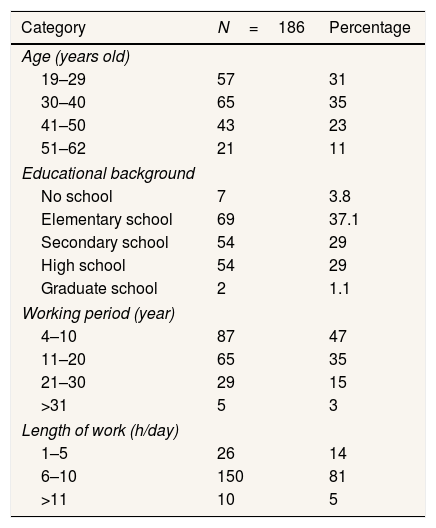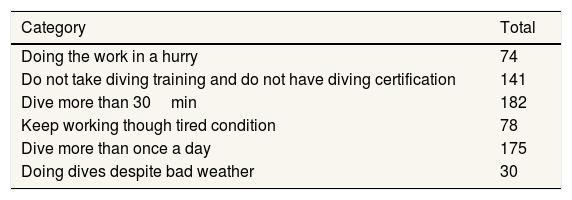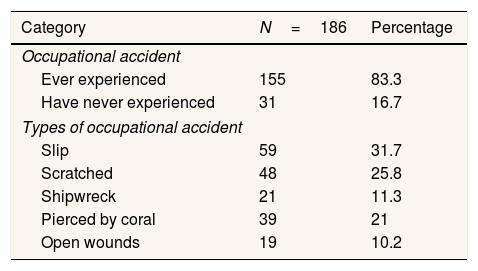
The 1st International Conference on Safety and Public Health
More infoThe research aims to identify human error committed by traditional divers while fishing, and to determine the relationship between human error as a cause of occupational accidents at sea.
MethodA cross-sectional study with total of 186 traditional divers participated. The data was collected by questionnaires, and analyzing with chi-square test (p-value=0.05).
ResultsMore than 83% of respondents had experienced occupational accident and behave human error while diving (81%). Type of human error such as rush of work, never attend safety training and does not have diving certificate, dives more than 30min, continues to work even tired, dives more than once a day, and continues to dive despite bad weather. The types of occupational accidents were slips, scratches, shipwrecks, hit by rocks, and suffered open wounds. The statistical test p value=0.000 (<0.05) and OR=44.883.
ConclusionsThere is a relationship between human errors and occupational accident.
Indonesia is the largest archipelagic country in the world consisting of 17,508 islands (6000 of which are inhabited islands), with a population of 247.5 million people making Indonesia the fourth largest country with the largest population in the world.1 More than 60% of Indonesia's total population lives in coastal areas with the majority of their livelihoods as fishermen and divers.2,3
Traditional divers are divers who learn to dive naturally from their family and friends. They are not educated to dive properly and only dive with a simple equipment.4 Traditional dive is a profession that is widely practiced by mining fishermen or fishermen who seek fish. In other words, a traditional diver is an unsecured diver.3
The risks may include animal attacks, physiological stresses, exposure to toxins and carcinogens, and dangerous environmental conditions.5 Diving activity is one of the activities has a high risk to the safety and health of the divers,5,6 event an accident.7 The activities carried out by traditional divers, are full of challenges, one of which is having an accident while working. National Transportation Safety Committee assessed that 90% of accidents at sea was caused by human factor8,9 that are dangerous due to lack of knowledge, fatigue, skills, and also attitude and behavior that is not secure.8 Other factors that cause accidents at sea due to natural factors of 33.57% and technical error factors of 23.35%.10 The incidents due to health problems in Asia range from 1 to 35 incidents per 1000 divers. In Indonesia, as many as 81 respondents experienced diseases resulting from diving.11
The study from Embuai et al. (2019) shows that the complaints often felt by divers are complaints of dizziness/headache 21.2%, felt tired 12.6%, decreased hearing frequency by 12.5%, feeling pain in joints 10.8%, noise problems 10.2%, feeling shortness of breath 9.7%, experiencing a decrease in vision 6.4%, suffering from skin disorders 6.0%, being exposed to sea animal bites 5.6%, experiencing paralysis 3.2%, and loss of consciousness 1.7%.11,12
Derawan Island is an archipelago located in Berau Regency, East Kalimantan Province which is one of the favorite destinations for tourists because of its underwater beauty. A half of people living on this island are fishermen and traditional divers for their livelihoods. Based on a report by the local newspaper of Berau in 2015, there were four tourists reported missing in the Sangalaki Island during the dive. In 2019 there have been 2 deaths due to this diving on Kakaban Island. And the beginning of 2020 there is an accident occurred to a fisherman who did dives to a depth of 10 meters and experiences cramps causing death. Therefore, the aim of this research is to identify human error committed by traditional divers while fishing, and to determine the relationship between human error as a cause of occupational accidents at sea.
MethodThis is a quantitative study with a cross-sectional design. This research was taken place in Derawan Island, tourism area in Regency of Berau, East Borneo Province, Indonesia during June–July, 2020. The purposive sampling was determined from this research with total of 186 traditional divers were participated. The data collected by questionnaires and observation. Data analysis used chi-square test with a confidence level of 95% (α=0.05).
ResultsIndividual characteristics of respondentTable 1 shows that mostly the traditional divers are 30–40 years old (35%) with educational background is only up to elementary school. Working period traditional divers, namely from 4 to 10 years as many as 87 traditional divers (47%), while the majority of the length of time working in a day from 6 to 10h.
Distribution of characteristic respondents.
| Category | N=186 | Percentage |
|---|---|---|
| Age (years old) | ||
| 19–29 | 57 | 31 |
| 30–40 | 65 | 35 |
| 41–50 | 43 | 23 |
| 51–62 | 21 | 11 |
| Educational background | ||
| No school | 7 | 3.8 |
| Elementary school | 69 | 37.1 |
| Secondary school | 54 | 29 |
| High school | 54 | 29 |
| Graduate school | 2 | 1.1 |
| Working period (year) | ||
| 4–10 | 87 | 47 |
| 11–20 | 65 | 35 |
| 21–30 | 29 | 15 |
| >31 | 5 | 3 |
| Length of work (h/day) | ||
| 1–5 | 26 | 14 |
| 6–10 | 150 | 81 |
| >11 | 10 | 5 |
Source: Primary Data (2020).
There are two categories of behavior performed by traditional divers, where as many 151 respondents (81.2%) included human error. Meanwhile, 35 respondents (18.8%) in category of safe behavior during diving activities (Tables 2 and 3).
Types of human error (unsafe action) by traditional divers.
| Category | Total |
|---|---|
| Doing the work in a hurry | 74 |
| Do not take diving training and do not have diving certification | 141 |
| Dive more than 30min | 182 |
| Keep working though tired condition | 78 |
| Dive more than once a day | 175 |
| Doing dives despite bad weather | 30 |
Source: Primary Data (2020).
Table 4 shows that the type of accident most often experienced by respondent is that slipped while on the ship as many as 59 respondents with a percentage 31.7%, while the type of accident is lowest or rare experienced by respondents, namely shipwreck or sinking as many as 18 respondents by percentage 9.7%.
Relationship of human error toward occupational accidentsBased on Table 5, the respondent perform human error and ever experienced occupational accidents, namely 144 respondents (77%). Meanwhile, respondents did safe behavior but have had an occupational accident, namely 11 respondents with a percentage 6%. Chi-square test results that p-value (0.000)<α(0.05), so it can be concluded that there is a relationship between human error and occupational accident among traditional divers on Derawan Island. The odds ratio value shows a result of 44,883 which means that the respondent behaving human error has a chance of experiencing an occupational accident 44 times compared to respondents who applied safe behavior.
Result of chi-square test.
| Occupational accident | N=186 | p-value | OR (CI 95%) | ||
|---|---|---|---|---|---|
| Ever experienced | Have never experienced | ||||
| Behavior traditional divers | |||||
| Human error | 144 (77%) | 7 (4%) | 151 (81%) | 0.000 (<0.05) | 44.883 (15.840–127.176) |
| Safe behavior | 11 (6%) | 24 (13%) | 35 (19%) | ||
| Total | 155 (83%) | 31 (17%) | 186 (100%) | ||
95%CI: 95% confidence interval; OR: odds ratio. Source: Primary Data (2020).
The results showed that as many as 81.2% who did human error (unsafe action) experienced occupational accidents as much as 83.3%. This is in line with the research of Kairupan et al. (2019) which states that almost all workers do not perform safe behavior while doing work, so the increasing number of occupational accidents.13
The reasons for the respondents doing human error during work were due to several factors. Respondents will work in a hurry and continue to work even though they are tired. Work fatigue has a significant relationship with occupational accidents and almost every worker who experiences fatigue work has a very high risk of having an occupational accident.14,15 Fatigue experienced by traditional divers due to lack of rest time after activity.16 Apart from working as a fisherman who looks for fish using diving techniques, there are also other activities, namely as a tour guide. This is because Derawan Island is one of favorite tourist destinations for tourists. If they work in a drowsy state due to fatigue and physical conditions that are not prime, the possibility of experiencing errors in work is also high which will have an impact on the occurrence of occupational accidents.17
Human factors play an important role in occupational accidents, one of which is an educational level of worker.18 The results of this study indicate that the majority of traditional divers education is an elementary school with a percentage of 37.1%. Research conducted by Lela et al. (2019) states that a person's attitude can change when he participates in intense training. Educational background has a role in influencing every action a person takes.19,20 The traditional divers do not have sufficient knowledge about diving that is safe for body health. For them, it is important to dive properly and not to endanger health. Which only dives based on experience without being equipped with adequate equipment.9 Training is very important for the traditional divers to get dive knowledge and minimizing the occurrence of occupational accidents during the dive.
Most of the respondents also dived more than the minimum limit. The minimum length of diving is 30min and the maximum length of diving is 50min below sea level. The longer a person dives, the higher the risk of experiencing occupational accidents and occupational diseases such as experiencing decompression, cramps, barotrauma, and being bitten by marine animals such as snakes and others.21 Therefore divers must dive to the minimum to avoid fatigue. Embuai et al. (2019) in his research states that 65.20% of diver who exceed the maximum time limit specified in diving have a significant association with occupational diseases.11
The most frequent occupational accident experienced by traditional divers, namely slipping while on board, amounting to 31.7%. This matter in line with Linda and Ratih's research, which explains that apart from unsafe action factors that can cause accidents work environment factor (unsafe condition) is also a cause the occurrence of work accidents and the types of accidents that occur, namely slipped due to the slippery floor conditions.22
ConclusionsThe frequency of occupational accidents experienced by traditional divers on Derawan Island is 155 out of 186 respondents, which means that most traditional divers have experienced occupational accidents. The number of respondents who had human error (unsafe action) when diving was 151 respondents out of 186 respondents. Finally, there is a significant relationship between Human Error and Occupational Accidents among traditional diver.
In summary, involving traditional divers in health training activities to increase knowledge and insight about the importance of implementing safe behavior when diving in order to minimize the occurrence of occupational accidents, providing sanctions for safety violators and giving rewards can also be additional motivation, appointing cadres as safety policeman in charge of monitoring diving activities is a good choice to implement, traditional divers also should always preserve the natural environment on Derawan Island.
Conflicts of interestThe authors declare that they have no conflict of interest.
Peer-review under responsibility of the scientific committee of the 1st International Conference on Safety and Public Health (ICOS-PH 2020). Full-text and the content of it is under responsibility of authors of the article.



















